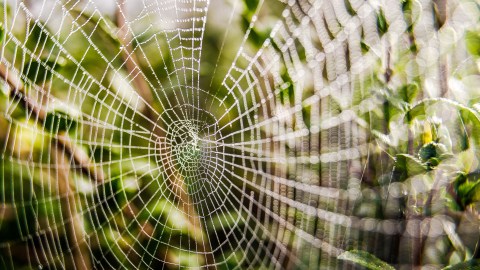Scientists Have Enhanced Spider Silk Using Nanotubes

Have you ever watched a spider make its web? What we consider lowly or for some (myself included) fear-inducing creatures, are actually master architects, hunters, and artists. It didn’t happen overnight. It’s a process spiders have been perfecting over the past 400 million years. No doubt, spider silk is strong, versatile stuff. There’s a rumor that it’s stronger than steel. Though it isn’t exactly (see video at the end), this enhanced version definitely is.
In a study published in the journal 2D Materials, UK and Italian researchers wanted to see if they could make spider silk stronger than its natural state. These scientists took spiders and put either graphene or nanotubes in their water supply. Graphene is one of the strongest artificial materials out there. And it’s just one atom thick.
Next, they tested the silk these spiders produced for strength and toughness. From a technical standpoint, spider silk measures up in toughness to any artificial polymer fiber, including Kevlar—the strongest material on Earth. It isn’t only strength and toughness scientists are interested in. Spider silk is also biodegradable and it conducts heat. As such, it has a lot of practical applications.

Enhanced spider silk could allow us to create a host of products with astonishing properties. Getty Images.
Researchers believe imbuing it with certain properties, such as electrical conductivity or magnetism, could help us create novel materials for use in a whole host of items including: sensors, sutures, flak jackets, bullet proof vests, lightweight wear-resistant clothing, artificial tendons or ligaments, parachutes, and so much more. Researchers believe fortifying spider silk would significantly increase the lifespan of these items as well.
There are lots of highly complex biological, physical, and chemical processes a spider’s body goes through to produce silk, making artificial production exceedingly difficult. Harvest it directly from the gland and you’ll find that it’s far inferior to the spun variety.
Artificial methods of spinning, however, have not produced sufficient results. Researchers wanted to see if an additive in the water supply might do the trick. They were led by led by Professor Nicola Pugno at the University of Trento, Italy.
She said,
We already know that there are biominerals present in in the protein matrices and hard tissues of insects, which gives them high strength and hardness in their jaws, mandibles and teeth, for example. So our study looked at whether spider silk’s properties could be ‘enhanced’ by artificially incorporating various different nanomaterials into the silk’s biological protein structures.
At its strongest, the enhanced spider silk was five times stronger than any found in nature. This is only a proof of concept study. Much more research must be done to better understand the process that’s taken place.

Artificial spider silk hasn’t been successfully reproduced. Getty Images.
Other natural products such as silk from silkworms and limpets’ “teeth”—the only natural thing stronger than spider silk, could be enhanced in this manner as well, scientists say, and used in different products. Limpets are mollusks. Their so-called teeth allow them to hold onto rocks and anchor themselves. This additive process could even be used in plants. Researchers are calling the resulting materials “bionicomposites.”
One downside, with animals there’s a moral issue. These results predict spiders filling millions of tanks, fed nanotube-laden water and pumping out silk for commercial products. In the near future, it could become a case like with other industries, where we simply turn a blind eye. On the practical side, something the study supports is the use of nanotubes. Previous research looked into several artificial substances introduced into the systems of spiders, including nanoparticles and superconducting crystals. The clear winner, where stronger silk is concerned, is nanotubes.
To hear more about the comparison between spider silk (in its natural state) and steel, click here:





